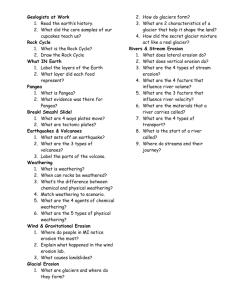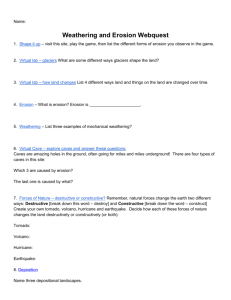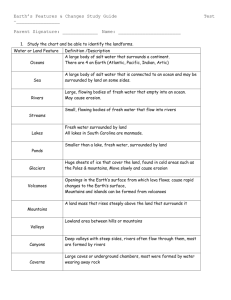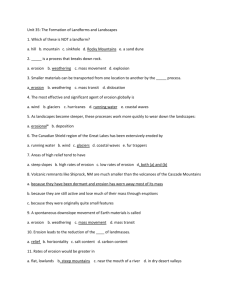Science CRCT Review - Effingham County Schools
advertisement
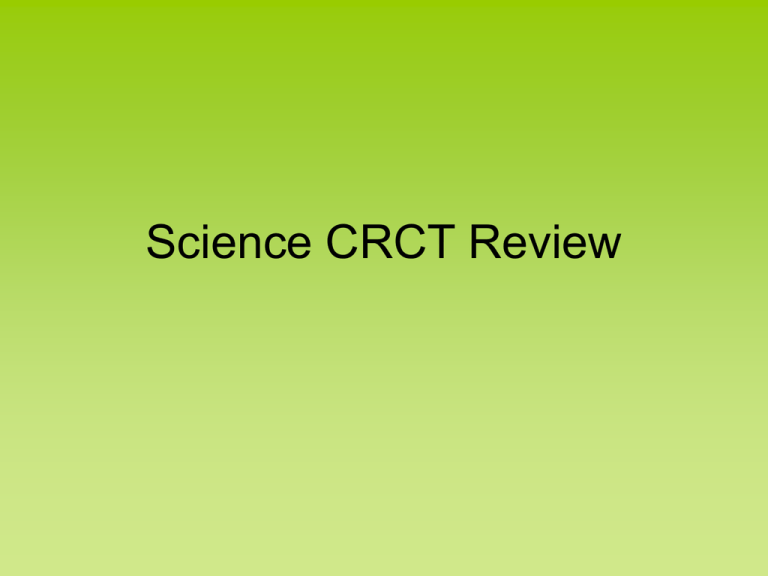
Science CRCT Review At the mouth of a river that empties into an ocean a river delta is formed. The delta is a result of __________. a. b. c. d. Erosion Deposition Pollution Condensation The Hawaiian Islands were formed as a result of _________. a. b. c. d. Deposition Hurricanes Glacier Volcanic activity The molecules in a gas _______. a. b. c. d. Are packed close together Stay close together Do not stay close together Form a regular pattern The smallest particle of matter is called a/an __________. a. b. c. d. Magnet Mass Atom Molecule Which of these tools is most useful for studying bacteria? a. b. c. d. Telescope Microscope Binoculars Two-pan balance A vertebrate is an animal that ___________. a. b. c. d. Has a backbone Does NOT have a backbone Is only found on land Is only found in lakes and rivers The holes in this rock were most likely formed by _____________. a.A constructive force b.A landslide c.A sinkhole d.Weathering and erosion How do glaciers move materials? a. Glaciers are pushed by sinkholes. b. Glaciers cause magma to rise. c. Glaciers push rock and soil in front of them. d. Glaciers do not move. A scientist has a sheet of paper. After an experiment, the paper has turned to ash. The scientist is investigating ___________ a. b. c. d. Density Mass and weight Chemical changes Physical changes A pathway of an electric current that contains a power source and a conductor is called __________. a. b. c. d. Electric circuit Static electricity Magnetic poles Insulators Which of the following is NOT an example of harmful bacteria? a. Microorganisms that can cause food to spoil. b. Bacteria cause cholera, an often fatal disease. c. Microorganisms used to clean up an oil spill. d. Bacteria causing food poisoning. Which of the following is an example of a gymnosperm? a. b. c. d. A tomato plant A wildflower An apple tree A fir tree Water and winds are the two forces that cause __________. a. b. c. d. Earthquakes Glacier Erosion Volcanoes Which of the following is used for flood control? a. b. c. d. Dams Levees Windbreaks Both a and b Which of the following is NOT an example of a physical change? a. b. c. d. A melting popsicle Breaking a window Paper burning Water evaporating from a puddle A bicycle is left out in the rain and rusts. What kind of change is this? a. b. c. d. Physical change Chemical change Energy change Change of state Animals that spend part of their lives in water and part on land are called _____________ a. b. c. d. Fish Reptiles Amphibians Mammals Which cell part is found in plant cells but not in animal cells? a. b. c. d. Cell membrane Nucleus Cell wall Cytoplasm By studying the wavy lines of a seismograph, scientists can _________. a. b. c. d. Prevent earthquakes Cause earthquakes Ignore earthquakes Measure earthquakes Erosion and weathering are examples of ________. a. b. c. d. Constructive forces Destructive forces Surface features Land build up What makes an electromagnet different from a bar magnet? a. Only an electromagnet attracts materials made of iron b. Only an electromagnet can be turned on and off c. Only a bar magnet has a magnetic field d. Only a bar magnet has poles Which of the following is NOT needed to make an electromagnet? a. b. c. d. A bar magnet Wire An iron core to wrap the wire around Energy source (battery) An animal that does NOT have a backbone is called a/an __________. a. b. c. d. Carnivore Herbivore Vertebrate Invertebrate ________ play(s) a role in the transfer of traits from parents to offspring. a. b. c. d. Genes Cell membrane Cytoplasm Chloroplast What are two surface features that can result from magma pushing up Earth’s crust? a. b. c. d. Glacier and a fold mountain Weathering and erosion Landslide and sinkhole A dome-shaped mountain or a volcano can form What term describes a mass of snow and ice in motion? a. b. c. d. Loss deposition Glacier Outwash Abrasion A change in matter that produces new kinds of matter is called a _________. a. b. c. d. Chemical change Physical change Change in state Particle change You have a battery and a bulb. What else do you need to make a simple circuit? a. b. c. d. Wires Insulator Static electricity A source of electric current How does this single-celled organism move? a. b. c. d. By trapping nutrients By latching onto a bacteria By moving its tiny hair-like structures By moving its tail back and forth Plants can be sorted into two major groups _________ and ________. a. b. c. d. Flowering and non-flowering Vascular and non-vascular With cells and without cells Large and small The Grand Canyon was formed as a result of __________. a. b. c. d. A volcano An earthquake Erosion A glacier _____________ is any process that changes a rock’s chemical composition. a. Mechanical or physical weathering b. Chemical weathering c. Oxidation d. Erosion A build up of electric charge is called ___________. a. b. c. d. Electrically neutral A like charge Static electricity An unlike charge Which direction does a needle of a compass always point? a. b. c. d. North South East West Vertebrates can be sorted into ___________ groups. a. b. c. d. 2 3 4 5 Why don’t animals have chloroplast? a. Chloroplast are used to make food in a plant cell b. Chloroplast are used as the brain center of an organism c. Chloroplast are only found in singlecelled organisms d. Chloroplast are responsible for learned behaviors. What are two surface features that can result from magma pushing up Earth’s crust? a. b. c. d. Glacier and a fold mountain Weathering and erosion Landslide and sinkhole A dome-shaped mountain or a volcano can form The carrying away of sediment by moving water, wind or moving ice is called ___________. a. b. c. d. Weathering Sediment Erosion Wind Which of the following shows energy being taken away from something? a. Sun shining on a parking lot b. A cup of warm water being placed in a refrigerator c. Solid iron is melted d. A snowman melting Which of the following is NOT an example of a series circuit? a. c. b. d. Which of the following is NOT an example of an inherited trait? a. b. c. d. Shape of face Eye color Tying shoes Blood type Which of the following vertebrates is cold-blooded but has lungs? a. b. c. d. Fish Mammals Birds Reptiles A seismologist studies ________. a. b. c. d. Weather Plants Earthquakes fossils Sand dunes are hills of sand that form in deserts and along seashores where winds are strong. Sand dunes are the result of __________ . a. b. c. d. Erosion Deposition Pollution Chemical weathering Materials that electric charges do not move through easily are called __________. a. b. c. d. Insulators Conductors Molecules Atoms The picture below shows an example of a molecule in its ________ state. a. b. c. d. Solid Liquid Gas Water vapor Angiosperms are plants that ___________. a. Do not have chloroplast b. Grow on the sides of mountains but not in valleys c. Do NOT produce flowers and fruit d. Do produce flowers and fruit Which of the following is an invertebrate? a. b. c. d. Frog Worm Monkey Bird The changes that occurred in the picture below are probably due to _________. a. b. c. d. Pollution Erosion Tornadoes Condensation 2001 2011 The islands of Japan were formed by __________. a. b. c. d. Deposition Hurricanes Glaciers Volcanic activity What kind of change changes water from a liquid to a solid? a. b. c. d. Physical change Chemical change Particle change Matter change The picture below shows a _________ charge. a.Positive b.Negative c.Neutral d.Chemical ---++ -++ Fish breathe using ________. a. b. c. d. Lungs Scales Gills Fins Animals must find their own food; however plants _________. a. b. c. d. Do not need food Eat food from the ground Make their food inside their cells Wait for animals to bring them food An earthquake is caused by an abrupt shift in the earth along a fracture or ___________. a. b. c. d. Fault Seismic waves Geiger counter Plate Christopher was looking at pictures of different mountain ranges in the United States. He is surprised to see that the Appalachian Mountains were smaller and more rounded than the Rocky Mountains. Why did the Appalachian Mountains looked older and worn compared to the Rocky Mountains? a. b. c. d. The effect of wind and water caused erosion, wearing away the mountains. Too many people and animals traveled across the mountains, causing them to wear away. All of the snowfall was so heavy that it weighted down the mountains and caused them to shrink. The water that used to cover Earth wore away parts of the mountains. The molecules in a gas a. b. c. d. Are packed close together. Stay close together. Do not stay close together. Form a regular pattern. You find the mass of a pack of gum. Then you find the mass of all the sticks and the wrappers. How do these measurements compare? a. The two measurements are the same. b. The pack has a larger mass than the sticks and wrappers. c. The sticks and wrappers have a larger mass than the pack. d. The sticks and wrappers have a smaller mass than the pack. Unlike plants in other groups, gymnosperms produce a. b. c. d. Fruits and flowers Seeds in cones Roots and stems Tall, woody plants Which of the following is characteristic of birds and mammals only? a. b. c. d. They lay eggs. They have a backbone. They have radial symmetry. They are warm-blooded. Which of these surface features can be formed by ocean waves? a. b. c. d. Sea caves Mountains Volcanoes Ponds A river cutting a V-shaped valley is an example of a. b. c. d. A sinkhole A landslide Weathering and erosion A constructive process Magma flowing out of Earth’s crust formed which of the following features? a. b. c. d. The Himalayas The Mississippi River delta The islands off the coast of Georgia The islands of Hawaii Where could you most likely observe a volcano? a. b. c. d. Northern Georgia The rim of the Pacific Ocean Florida The Himalayas The Rocky Mountains are examples of a. b. c. d. Dome mountains Fold mountains Fault-block mountains Volcanoes Sandbags are piled along the banks of a rising river to form a a. b. c. d. Temproary levee Temporary dam Reservoir Storm drain system People build which of these structures to slow beach erosion? a. b. c. d. Barrier island River dam Reservoir Sea wall A scientist has a sheet of paper. After an experiment, the paper has turned to ash. The scientist is investigating a. b. c. d. Density Mass and weight Chemical changes Physical changes The total energy of the particles of matter is called a. b. c. d. Expansion Contraction Thermal energy heat What kind of change is a change in state? a. b. c. d. Physical change Chemical change Particle change Matter change The ability to remove salt from seawater shows that making a solution is a a. b. c. d. Change of state Particle change Chemical change Physical change A bicycle left in the rain rusts. What kind of change is this? a. b. c. d. Physical change Chemical change Energy change Change of state A build-up of electric charge is called a. b. c. d. Electrically neutral A like charge Static electricity An unlike charge You have a battery and a bulb. What else do you need to make a simple circuit? a. b. c. d. Wire An insulator Static electricity A source of electric current What makes an electromagnet different from a bar magnet? a. Only an electromagnet attracts materials made of iron. b. Only an electromagnet can be turned on and off. c. Only a bar magnet has a magnetic field d. Only a bar magnet has poles. The function of mitochondria is to a. b. c. d. Store materials Make energy from sunlight Break down sugars to release energy Control movement of materials in and out of the cell What makes a multi-celled organism different from one that is single-celled? a. Only multi-celled organisms have cells that work together to form specific functions. b. Only multi-celled organisms make energy from sugars. c. Only multi-celled organisms have organelles. d. Only multi-celled organisms have cells that divide. Information about inherited traits is stored in _________. a. b. c. d. ATP DNA Chloroplasts Cytoplasm The stronger gene for a given trait is called the _________ gene. a. b. c. d. Dominant Recessive DNA Chromosomic

